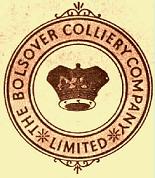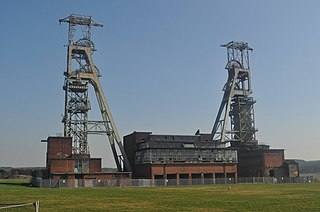
Worksop is a market town in the Bassetlaw District in Nottinghamshire, England. It is located 15 miles (24 km) south of Doncaster, 15 miles (24 km) south-east of Sheffield, and 24 miles (39 km) north of Nottingham. Located close to Nottinghamshire's borders with South Yorkshire and Derbyshire, it is on the River Ryton and not far from the northern edge of Sherwood Forest. Other nearby towns include Chesterfield, Gainsborough, Mansfield and Retford. The population of the town was recorded at 44,733 in 2021 Census.

Eastwood is a former coal mining town in the Broxtowe district of Nottinghamshire, England, 8 miles (13 km) northwest of Nottingham and 10 miles (16 km) northeast of Derby on the border between Nottinghamshire and Derbyshire. Mentioned in Domesday Book, it expanded rapidly during the Industrial Revolution. The Midland Railway was formed here and it is the birthplace of D. H. Lawrence. The distinctive dialect of East Midlands English is extensively spoken, in which the name of the town is pronounced.

Calverton is a village and civil parish in Nottinghamshire, of some 3,300 acres (1,300 ha), in the Gedling district, about 7 miles north-east of Nottingham, and 10 miles south-east of Mansfield. England, and situated, like nearby Woodborough and Lambley, on one of the small tributaries of the Dover Beck. The 2021 census found 7,579 inhabitants in 3,326 households. About two miles to the north of the village is the site of the supposed deserted settlement of Salterford.

Nottinghamshire is a county that is situated in the East Midlands of England. The county has history within Palaeolithic period, dating anywhere between 500,000 and 10,000 b.c.e., as well as early Anglo-Saxon communities, dating to 600 c.e. Furthermore, the county has significance in the political aspects of English history, particularly within intercommunal fighting, and its economics is historically centred around coal and textiles.

The National Coal Mining Museum for England is based at the site of Caphouse Colliery in Overton, Wakefield, West Yorkshire, England. It opened in 1988 as the Yorkshire Mining Museum and was granted national status in 1995.
Bothamsall is a village and civil parish in the Bassetlaw district of Nottinghamshire, England.

Clipstone in north Nottinghamshire is a small ex-coal mining village built on the site of an old army base and close to the site of a medieval royal palace. The population of the civil parish was 3,469 at the 2001 census, increasing to 4,665 at the 2011 census.

Pinxton is a village and civil parish in Derbyshire on the western boundary of Nottinghamshire, England, just south of the Pinxton Interchange at Junction 28 of the M1 motorway where the A38 road meets the M1. Pinxton is part of the Bolsover District and at the 2011 Census had a population of 5,699. "Pinxton CCTV level crossing", located on the up and down Kirkby lines, is a major tourist attraction for train enthusiasts who come from all over the country to take photographs of some of the unique locomotives that pass over the crossing.

Meden Vale is a small former coal mining village originally known as Welbeck Colliery Village prior to renaming in the late 1960s.

Snibston is an area and former civil parish east of Ravenstone, now in the parish of Ravenstone with Snibstone, in the North West Leicestershire district, in the county of Leicestershire, England. Originally rural, part of Snibston was transformed into a coal mining village by the opening of coal mines by the Snibston Colliery Company in the early 1830s. This industrial part of Snibston was subsequently subsumed into the developing town of Coalville, though small rural areas of Snibston survive within the civil parishes of Ravenstone with Snibston and Hugglescote and Donington le Heath. In the part of Snibston within the latter civil parish stands the 13th-century church of St Mary, noted as the smallest church still in use for regular worship in England. The main Snibston Colliery was sunk in 1831, and after its closure the Snibston Country Park with the Snibston Discovery Museum was built on part of the colliery site. Part of the park is Snibston Grange Local Nature Reserve.

The Bolsover Colliery Company was a major mining concern established to extract coal from land owned by the Duke of Portland. At its peak the business was a constituent of the FT 30 index of leading companies on the London Stock Exchange.

Clipstone Colliery was a coal mine in the village of Clipstone, Nottinghamshire, part of the area known as The Dukeries. The colliery opened in 1922 and operated until 2003. It was built by the Bolsover Colliery Company, transferred to the National Coal Board in 1947, then operated by RJB Mining from 1994. The headstocks and powerhouse are grade II listed buildings so have been preserved.

Pleasley Colliery is a former English coal mine. It is located to the north-west of Pleasley village, which sits above the north bank of the River Meden on the Nottinghamshire/Derbyshire border. It lies 3 miles (4.8 km) north of Mansfield and 9 miles (14.5 km) south of Chesterfield. From the south it commands a prominent position on the skyline, although less so now than when the winders were in operation and both chimney stacks were in place. The colliery is situated at about 500 ft (152m) above sea level and is aligned on a NE–SW axis following the trend of the river valley at this point.
Clipstone Colliery Sidings railway station was a station in Clipstone, Nottinghamshire.
Roy Lynk OBE was a leader of the Union of Democratic Mineworkers.

Kings Clipstone is a settlement and civil parish, in the Newark and Sherwood district, in the county of Nottinghamshire, England. The parish lies in the west of the county, and north west within the district. It is 122 miles north of London, 15 miles north of the city of Nottingham, and 5 miles north east of the market town of Mansfield. In 2011 the parish had a population of 318. The parish touches Clipstone village, Edwinstowe, Rufford and Warsop. The parish was formerly part of the wider Clipstone parish, on 1 April 2011 it became a separate parish. The area is within Sherwood Forest, well known for the Robin Hood legend.

Warsop Vale is a small village in the Mansfield district of western Nottinghamshire, England. It is 120 miles (190 km) north west of London, 17+1⁄2 miles (28.2 km) north of the county town and city of Nottingham, and 4+1⁄4 miles (6.8 km) north of the town of Mansfield. It is in the civil parish of Warsop. Warsop Vale's heritage is primarily as a former mining village. It lies in the very picturesque area known as the Dukeries and is easily accessible to Clumber Park, Thoresby Park and hall, Rufford Park and the Earl of Portland estate of Welbeck, together all part of Sherwood Forest.
Bothamsall is a civil parish in the Bassetlaw District of Nottinghamshire, England. The parish contains nine listed buildings that are recorded in the National Heritage List for England. All the listed buildings are designated at Grade II, the lowest of the three grades, which is applied to "buildings of national importance and special interest". The parish contains the village of Bothamsall and the surrounding countryside. The listed buildings consist of a country house, smaller houses and cottages, farmhouses, a church and a bridge.














